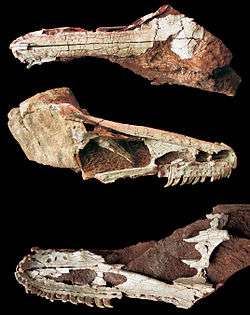Xixiasaurus
| Xixiasaurus Temporal range: Late Cretaceous, 86 Ma | |
|---|---|
 | |
| Skull | |
| Scientific classification | |
| Kingdom: | Animalia |
| Phylum: | Chordata |
| Class: | Reptilia |
| Clade: | Dinosauria |
| Order: | Saurischia |
| Suborder: | Theropoda |
| Family: | †Troodontidae |
| Genus: | †Xixiasaurus Lü et al., 2010 |
| Species: | †X. henanensis |
| Binomial name | |
| Xixiasaurus henanensis Lü et al., 2010 | |
Xixiasaurus is a genus of extinct troodontid dinosaur from the Late Cretaceous of modern-day China. It was first described as a new taxon in 2010. The type species is X. henanensis. Fossils of Xixiasaurus were discovered in central China, in the Majiacun Formation of Henan, and are believed to have been from the Late Cretaceous (Santonian-Coniacian age, about 86 million years ago). The fossils were described by a team of Chinese scientists composed of a group from the Chinese Academy of Geological Sciences in Beijing and a second group from the Henan Geological Museum in Henan. They chose the name Xixiasaurus henanensis, translating as "Henan Xixia lizard".
Description

Xixiasaurus is a troodontid, a group of small, bird-like, gracile maniraptorans. All troodontids have many unique features of the skull, such as closely spaced teeth in the lower jaw, and large numbers of teeth. Troodontids have sickle-claws and raptorial hands, and some of the highest non-avian encephalization quotients, meaning they were behaviourally advanced and had keen senses.[1] Xixiasaurus is about 1.2 m (3.9 ft) long.[2] It is one of few troodontids that have no serrations on its teeth, similar to its closest relative Byronosaurus. Xixiasaurus has fewer teeth than Byronosaurus and Mei, but more than Sinornithoides, Zanabazar and Saurornithoides. Like Bryonosaurus, the palate is extensive, and the teeth are heterodont.[1]
Xixiasaurus is known from a mostly complete skull, only lacking the posterior portion. The top of the snout is slightly displaced, but overall, the skull resembles Bryonosaurus. As the nasal bones are very not and not completely fused, the holotype of Xixiasaurus may have died immature. Most of the braincase is preserved, as well as most teeth and all tooth sockets. Viewed from below, the tooth rows form a U-shaped curve. Some small pits are present of the lateral surface of the maxilla. The teeth on the maxilla are larger than those in the premaxilla. The hand and lower arm are also preserved. The claw of the first digit is very large, with a large flexor tubercle. The first phalanges of the first two digits are 3.6 cm (1.4 in) and 3 cm (1.2 in) long, respectively.[1]
Discovery

Xixiasaurus henanensis was first described in 2010 as a new binomial, which was from the Late Cretaceous of China. The holotype specimen is HGM 41HIII−0201, which includes most of a skull and a partial lower arm. Xixiasaurus was chosen as the genus name in reference to the Xixia Basin, where the fossils were found, and saurus, meaning "lizard". The species name was chosen for the Henan Province, where the basin is located.[1] Thus, the name translates to "Henan Xixia lizard".[2] Xixiasaurus is from the middle region of the Majiacun Formation, which dates to the Santonian-Coniacian, about 86 million years ago.[1]
See also
References
- 1 2 3 4 5 Junchang Lü; Li Xu; Yongqing Liu; Xingliao Zhang; Songhai Jia & Qiang Ji (2010). "A new troodontid (Theropoda: Troodontidae) from the Late Cretaceous of central China, and the radiation of Asian troodontids." (PDF). Acta Palaeontologica Polonica. 55 (3): 381–388. doi:10.4202/app.2009.0047.
- 1 2 Martyniuk, M.P. (2012). A Field Guide to Mesozoic Birds and Other Winger Dinosaurs. Pan Aves. p. 102. ISBN 978-0-9885965-0-4.